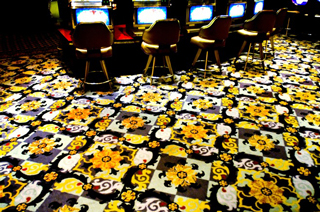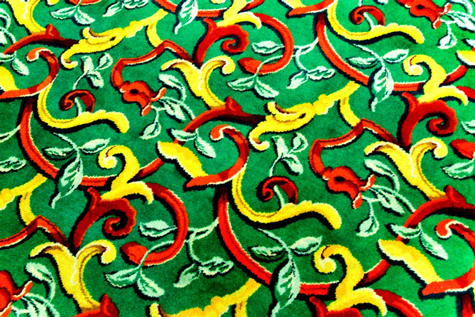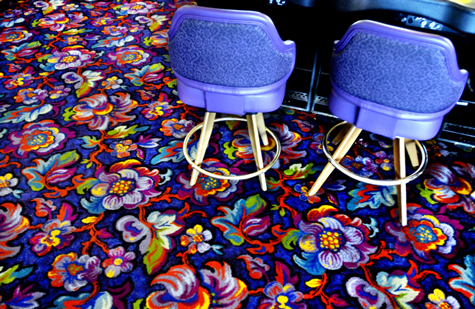Human Flower Project
The Figure in the Carpet
Haughty artists and garish floral carpets set the fantasy-prone off on a harrowing trip to Obsession.

From Chris Maluszynski’s Las Vegas Carpets series
Image: via Wired
“The thing’s as concrete there as a bird in a cage, a bait on a hook, a piece of cheese in a mouse-trap.”
So insists novelist Hugh Vereker about the great and delicious “secret” that runs through all his writings. He’s egging on a small-time literary critic, the unnamed narrator in Henry James’s story The Figure in the Carpet, dropping psychic crumbs that will keep his ambitious young admirer reading, studying, yearning to crack the artist’s code.
We read James’s intriguing novella today, egged on ourselves by some queasily strident photographs of carpets in Las Vegas casinos. They were taken by Swedish photographer Chris Maluszynski and featured earlier this year by both the Daily Mail and, most recently, Wired. Both articles quote Dave Schwartz, a scholar based at the University of Nevada, Las Vegas, who’s studied the psychology of casino décor: odorants, floor plans, the cushions on stools, and timbre of slot machine bells. Schwartz says, “Casino carpet is known as an exercise in deliberate bad taste that somehow encourages people to gamble.”
What’s taste have to do with it? Presumably, taste is an exercise of judgment and discernment, while gambling—the compulsive sort that keeps people up all night, and the next night, standing at the roulette wheel – requires that something override judgment, even disrupting such basic survival mechanisms as appetite and fatigue.

From Chris Maluszynski’s Las Vegas Carpets series
Image: via Wired
This kind of game playing is obsessive-compulsive. And in James’s novella, the author’s mighty secret is in several passages called “a game,” too. Quite suddenly, James’s nameless narrator loses all other thought or feeling —even the enjoyment he once took in literature—for a full-time fixation on discovering the critical nugget. Just so, the compulsive gambler’s initial pleasure with “playing” boomerangs. It becomes work, then enslavement – a shrunken world. The fictional Gwendolen Corvick, who also becomes obsessed with Verecker’s secret, at last admits, “It’s my life!”
It’s hard to make throwing dice in a windowless room “a life.” Without some peculiar human psychochemistry it wouldn’t be possible. “Gambling games grew up around the frailty of our nervous system,” says Read Montague, a professor of neuroscience at Baylor University. “They evolved to exploit specific hiccups in our brain.”

From Chris Maluszynski’s Las Vegas Carpets series
Image: via Wired
Gamblers being superstitious sorts (sometimes paranoid too), there are a number of theories of casino carpets. Some people claim that the busy patterns, often red, yellow and green, conveniently hide chips dropped on the floor – another source of income for the house. But more likely, they camouflage months of foot traffic and spilled drinks. Floral images in the carpets veer about as far from botanical accuracy as possible (for purposes of contrast, look at the flowers in these Flemish tapestries, so very true to life). Yet the Las Vegas textile flowers aren’t stylized either: that would be too orderly and calming when the point is to keep eyes wide, adrenalin pouring. Instead, these flowers have a loopy, cartoonish quality, vaguely humorous and sinister at the same time.

From Chris Maluszynski’s Las Vegas Carpets series
Image: via Wired
Brains go looking for patterns—for “The Figure in the Carpet,” as James would say. If the pattern’s obvious, why hunt for it? But if it’s hard (or impossible) to construe yet we can be convinced it’s there, (which both Hugh Vereker and Harrod’s casino work hard to make us believe), then any lead or payoff makes “the big win” seem just around the corner. Along with Henry James, other storytellers obsessed with obsessions include Nathaniel Hawthorne (“Ethan Brand,” “Rappaccini’s Daughter,” “The Birthmark” and lots more) and filmmaker Darren Arnofsky in Pi.
“The trick of a one-armed bandit,” says Read Montague, “is that it provides us with the illusion of a pattern. We get enough rewards so that we keep on playing. Our cells think they’ll figure out the pattern soon. But of course they won’t.”
Meanwhile, the vibrating colors of casino carpets keep the gambler awake if dazed, and madly optimistic enough to go on spending despite the odds. Shapes underfoot, many of them floral, slither off into infinity, their designs boldly repetitive but somehow impossible to grasp. Like the great vine in Jack and the Beanstalk, they coax the player up, up, into the dangling cage.


The carpets are a bit psychedelic; reminds me of color swirls from 1960s and 70s cartoons